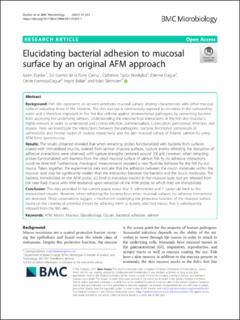| dc.contributor.author | Dunker, Karen | |
| dc.contributor.author | Gomez de la Torre Canny, Sol | |
| dc.contributor.author | Nordgård, Catherine Taylor | |
| dc.contributor.author | Dague, Etienne | |
| dc.contributor.author | Formosa-Dague, Cecile | |
| dc.contributor.author | Bakke, Ingrid | |
| dc.contributor.author | Sletmoen, Marit | |
| dc.date.accessioned | 2022-12-06T07:33:06Z | |
| dc.date.available | 2022-12-06T07:33:06Z | |
| dc.date.created | 2021-09-27T15:56:40Z | |
| dc.date.issued | 2021 | |
| dc.identifier.citation | BMC Microbiology. 2021, 21 . | en_US |
| dc.identifier.issn | 1471-2180 | |
| dc.identifier.uri | https://hdl.handle.net/11250/3035954 | |
| dc.description.abstract | Background
Fish skin represents an ancient vertebrate mucosal surface, sharing characteristics with other mucosal surfaces including those of the intestine. The skin mucosa is continuously exposed to microbes in the surrounding water and is therefore important in the first line defense against environmental pathogens by preventing bacteria from accessing the underlying surfaces. Understanding the microbe-host interactions at the fish skin mucosa is highly relevant in order to understand and control infection, commensalism, colonization, persistence, infection, and disease. Here we investigate the interactions between the pathogenic bacteria Aeromonas salmonicida (A. salmonicida) and Yersinia ruckeri (Y. ruckeri), respectively, and the skin mucosal surface of Atlantic salmon fry using AFM force spectroscopy.
Results
The results obtained revealed that when retracting probes functionalized with bacteria from surfaces coated with immobilized mucins, isolated from salmon mucosal surfaces, rupture events reflecting the disruption of adhesive interactions were observed, with rupture strengths centered around 200 pN. However, when retracting probes functionalized with bacteria from the intact mucosal surface of salmon fish fry no adhesive interactions could be detected. Furthermore, rheological measurements revealed a near fluid-like behavior for the fish fry skin mucus. Taken together, the experimental data indicate that the adhesion between the mucin molecules within the mucous layer may be significantly weaker than the interaction between the bacteria and the mucin molecules. The bacteria, immobilized on the AFM probe, do bind to individual mucins in the mucosal layer, but are released from the near fluid mucus with little resistance upon retraction of the AFM probe, to which they are immobilized.
Conclusion
The data provided in the current paper reveal that A. salmonicida and Y. ruckeri do bind to the immobilized mucins. However, when retracting the bacteria from intact mucosal surfaces, no adhesive interactions are detected. These observations suggest a mechanism underlying the protective function of the mucosal surface based on the clearing of potential threats by adhering them to loosely attached mucus that is subsequently released from the fish skin. | en_US |
| dc.language.iso | eng | en_US |
| dc.publisher | BMC | en_US |
| dc.rights | Navngivelse 4.0 Internasjonal | * |
| dc.rights.uri | http://creativecommons.org/licenses/by/4.0/deed.no | * |
| dc.title | Elucidating bacterial adhesion to mucosal surface by an original AFM approach | en_US |
| dc.title.alternative | Elucidating bacterial adhesion to mucosal surface by an original AFM approach | en_US |
| dc.type | Peer reviewed | en_US |
| dc.type | Journal article | en_US |
| dc.description.version | publishedVersion | en_US |
| dc.source.pagenumber | 13 | en_US |
| dc.source.volume | 21 | en_US |
| dc.source.journal | BMC Microbiology | en_US |
| dc.identifier.doi | 10.1186/s12866-021-02303-1 | |
| dc.identifier.cristin | 1939232 | |
| dc.relation.project | Norges forskningsråd: 268496 | en_US |
| dc.relation.project | Norges forskningsråd: 262929 | en_US |
| cristin.ispublished | true | |
| cristin.fulltext | original | |
| cristin.qualitycode | 1 | |

